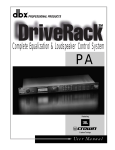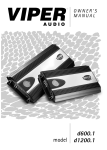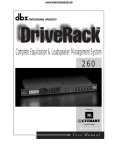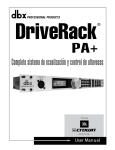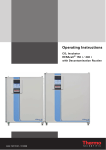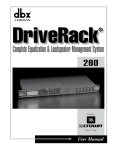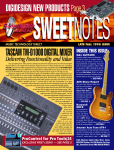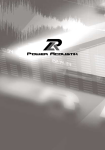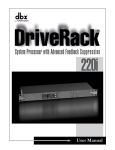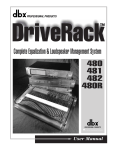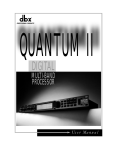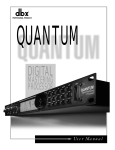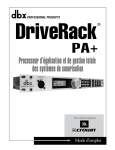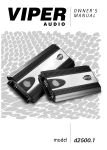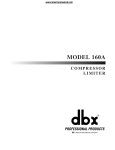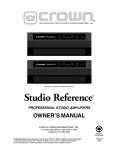Download Studio DriveRack Manual 6/18/03
Transcript
® Studio Monitor Management System Studio User Manual IMPORTANT SAFETY INSTRUCTIONS WARNING FOR YOUR PROTECTION READ THESE INSTRUCTIONS: CAUTION RISK OF ELECTRIC SHOCK DO NOT OPEN KEEP THESE INSTRUCTIONS A T T E N T I O N : RISQUE DE CHOC ELECTRIQUE - NE PAS OUVRIR W A R N I N G : TO REDUCE THE RISK OF FIRE OR ELECTRIC HEED ALL WARNINGS FOLLOW ALL INSTRUCTIONS SHOCK DO NOT EXPOSE THIS EQUIPMENT TO RAIN OR MOISTURE DO NOT USE THIS APPARATUS NEAR WATER The symbols shown above are internationally accepted symbols that warn of potential hazards with electrical products. The lightning flash with arrowpoint in an equilateral triangle means that there are dangerous voltages present within the unit. The exclamation point in an equilateral triangle indicates that it is necessary for the user to refer to the owner’s manual. These symbols warn that there are no user serviceable parts inside the unit. Do not open the unit. Do not attempt to service the unit yourself. Refer all servicing to qualified personnel. Opening the chassis for any reason will void the manufacturer’s warranty. Do not get the unit wet. If liquid is spilled on the unit, shut it off immediately and take it to a dealer for service. Disconnect the unit during storms to prevent damage. CLEAN ONLY WITH A DRY CLOTH. DO NOT BLOCK ANY OF THE VENTILATION OPENINGS. INSTALL IN ACCORDANCE WITH THE MANUFACTURER’S INSTRUCTIONS. DO NOT INSTALL NEAR ANY HEAT SOURCES SUCH AS RADIATORS, HEAT REGISTERS, STOVES, OR OTHER APPARATUS (INCLUDING AMPLIFIERS) THAT PRODUCE HEAT. ONLY USE ATTACHMENTS/ACCESSORIES SPECIFIED BY THE MANUFACTURER. UNPLUG THIS APPARATUS DURING LIGHTNING STORMS OR WHEN UNUSED FOR LONG PERIODS OF TIME. Do not defeat the safety purpose of the polarized or grounding-type plug. A polarized plug has two blades with one wider than the other. A grounding type plug has two blades and a third grounding prong. The wide blade or third prong are provided for your safety. If the provided plug does not fit your outlet, consult an electrician for replacement of the obsolete outlet. SAFETY INSTRUCTIONS NOTICE FOR CUSTOMERS IF YOUR UNIT IS EQUIPPED WITH A POWER CORD. Protect the power cord from being walked on or pinched particularly at plugs, convenience receptacles, and the point where they exit from the apparatus. WARNING: THIS APPLIANCE MUST BE EARTHED. The cores in the mains lead are coloured in accordance with the following code: GREEN and YELLOW - Earth BLUE - Neutral BROWN - Live Use only with the cart stand, tripod bracket, or table specified by the manufacture, or sold with the apparatus. When a cart is used, use caution when moving the cart/apparatus combination to avoid injury from tip-over. As colours of the cores in the mains lead of this appliance may not correspond with the coloured markings identifying the terminals in your plug, proceed as follows: • The core which is coloured green and yellow must be connected to the terminal in the plug marked with the letter E, or with the earth symbol, or coloured green, or green and yellow. • The core which is coloured blue must be connected to the terminal marked N or coloured black. • The core which is coloured brown must be connected to the terminal marked L or coloured red. This equipment may require the use of a different line cord, attachment plug, or both, depending on the available power source at installation. If the attachment plug needs to be changed, refer servicing to qualified service personnel who should refer to the table below. The green/yellow wire shall be connected directly to the units chassis. CONDUCTOR WIRE COLOR Normal Alt BLACK L LIVE BROWN N NEUTRAL BLUE E EARTH GND GREEN/YEL WHITE GREEN WARNING: If the ground is defeated, certain fault conditions in the unit or in the system to which it is connected can result in full line voltage between chassis and earth ground. Severe injury or death can then result if the chassis and earth ground are touched simultaneously. Refer all servicing to to qualified service personnel. Servicing is required when the apparatus has been damaged in any way, such as power-supply cord or plug is damaged, liquid has been spilled or objects have fallen into the apparatus, the apparatus has been exposed to rain or moisture, does not operate normally, or has been dropped. POWER ON/OFF SWITCH: For products provided with a power switch, the power switch DOES NOT break the connection from the mains. MAINS DISCONNECT: The plug shall remain readily operable. For rack-mount or installation where plug is not accessible, an all-pole mains switch with a contact separation of at least 3 mm in each pole shall be incorporated into the electrical installation of the rack or building. FOR UNITS EQUIPPED WITH EXTERNALLY ACCESSIBLE FUSE RECEPTACLE: Replace fuse with same type and rating only. MULTIPLE-INPUT VOLTAGE: This equipment may require the use of a different line cord, attachment plug, or both, depending on the available power source at installation. Connect this equipment only to the power source indicated on the equipment rear panel. To reduce the risk of fire or electric shock, refer servicing to qualified service personnel or equivalent. This Equipment is intended for rack mount use only. IMPORTANT SAFETY INSTRUCTIONS LITHIUM BATTERY WARNING CAUTION! This product may contain a lithium battery.There is danger of explosion if the battery is incorrectly replaced. Replace only with an Eveready CR 2032 or equivalent. Make sure the battery is installed with the correct polarity. Discard used batteries according to manufacturer’s instructions. ADVARSEL! Lithiumbatteri - Eksplosjonsfare.Ved utskifting benyttes kun batteri som anbefalt av apparatfabrikanten. Brukt batteri returneres apparatleverandøren. ADVARSEL! Lithiumbatteri - Eksplosionsfare ved fejlagtig håndtering. Udskiftning må kun ske med batteri av samme fabrikat og type. Levér det brugte batteri tilbage til leverandøren. VAROITUS! U.K. MAINS PLUG WARNING A molded mains plug that has been cut off from the cord is unsafe. Discard the mains plug at a suitable disposal facility. NEVER UNDER ANY CIRCUMSTANCES SHOULD YOU INSERT A DAMAGED OR CUT MAINS PLUG INTO A 13 AMP POWER SOCKET. Do not use the mains plug without the fuse cover in place. Replacement fuse covers can be obtained from your local retailer. Replacement fuses are 13 amps and MUST be ASTA approved to BS1362. DECLARATION OF CONFORMITY Manufacturer’s Name: Manufacturer’s Address: dbx Professional Products 8760 S. Sandy Parkway Sandy, Utah 84070, USA declares that the product: Product name: Note: dbx DriveRack Studio Product name may be suffixed by the letters-EU. Paristo voi räjähtää, jos se on virheellisesti asennettu.Vaihda paristo ainoastaan laitevalmistajan suosittelemaan tyyppin. Hävitä käytetty paristo valmistajan ohjeiden mukaisesti. Product option: VARNING! conforms to the following Product Specifications: Explosionsfara vid felaktigt batteribyte. Använd samma batterityp eller en ekvivalent typ som rekommenderas av apparattillverkaren. Kassera använt batteri enligt fabrikantens instruktion. None Safety: IEC 60065 (1998) EMC: EN 55013 (1990) EN 55020 (1991) Supplementary Information: ELECTROMAGNETIC COMPATIBILITY This unit conforms to the Product Specifications noted on the Declaration of Conformity. Operation is subject to the following two conditions: • this device may not cause harmful interference, and • this device must accept any interference received, including interference that may cause undesired operation. Operation of this unit within significant electromagnetic fields should be avoided. • use only shielded interconnecting cables. The product herewith complies with the requirements of the Low Voltage Directive 73/23/EEC and the EMC Directive 89/336/EEC as amended by Directive 93/68/EEC. Vice-President of Engineering 8760 S. Sandy Parkway Sandy, Utah 84070, USA Date: June 16, 2003 European Contact: Your local dbx Sales and Service Office or Harman Music Group 8760 South Sandy Parkway Sandy, Utah 84070 USA Ph: (801) 566-8800 Fax: (801) 568-7583 ® DriveRack Studio Table of Contents Introduction Section 5 - Application Guide 0.1 Defining the DriveRack Studio ......................ii 0.2 Service Contact Info........................................iii 0.3 Warranty...........................................................iv 5.1 2X4 Crossover.................................................30 5.2 Monitor Matrix Switcher.................................31 5.3 DriveRack Studio as a Studio Effects Unit....32 Section 1 - Getting Started Appendix 1.1 Rear Panel ......................................................2 1.2 Front Panel .....................................................2 1.3 Quick Start .....................................................3 A.1 A.2 A.3 A.4 A.5 A.6 A.7 Section 2 - Editing Functions 2.1 Basic Navigation Modes.................................12 2.2 Button Array Overview ..................................12 2.3 Navigating the EQ Section (GEQ/PEQ)........14 2.4 Navigating the Subharmonic Synthesizer Section....14 2.5 Navigating the Crossover Section..................14 2.6 Navigating the Feedback Suppression Section ..15 2.7 Navigating the Comp/Limiter Section ...........15 2.8 Navigating the Speaker Alignment Delay Section..................................................................15 2.9 Navigating the Utility Section ........................16 2.10 Navigating the Wizard Section ....................16 Factory Reset .................................................34 Quick Key Options........................................34 Specifications..................................................35 Auto EQ Optimization Tips ..........................36 Crossover Diagrams .......................................36 Block Diagram ...............................................37 Prog List..........................................................38 Section 3 - Operating the DriveRack Studio 3.1 Program Definition.........................................18 3.2 Navigating Factory Programs.........................18 3.3 Editing Factory Programs...............................18 Section 4 - Detailed Parameters 4.1 4.2 4.3 4.4 4.5 4.6 4.7 Pre-Crossover Graphic EQ.............................22 Advanced Feedback Suppressor ...................22 Subharmonic Synthesizer...............................23 Crossover ........................................................24 Post-Crossover Parametric EQ .......................25 Compressor/Limiter ........................................25 Speaker Alignment Delay .............................27 ® Table of Contents DriveRack User Manual ® DriveRack Studio INTRODUCTION INTRO CUSTOMER SERVICE INFO Defining the DriveRack WARRANTY INFO ® ® Introduction INTRODUCTION DriveRack Studio Drive your Studio to a whole new level of performance with the DriveRack® Studio Complete Equalization & Loudspeaker Control System. The DriveRack Studio from dbx Professional Products represents a complete integration of the key elements that help ensure optimal loudspeaker system management in Studio-specific applications. While the DriveRack was originally designed as an equalization and loudspeaker control system for PA applications, we found that it can also provide a host of essential functions in home, project and professional studio applications. In addition to the obvious equalization and compression functionality, the DriveRack Studio can help you tune your room, switch between up to three pairs of studio monitors, and (if you don’t have the luxury of multiple pairs of monitors) provide you with several different “Studio Monitor Emulation” templates. These templates allow you to hear your mixes as you would through everything from a small 5” speaker though traditional midfield monitors and beyond! 0.1 Defining the DriveRack Studio The dbx DriveRack Studio is the most effective way to manage all aspects of Loudspeaker management for Studio applications. The DriveRack Studio essentially becomes the only device that you will need for optimizing the playback monitoring in any studio. The following are just some of the features of the DriveRack Studio. DriveRack Studio features: • Dual 28-band Graphic EQ • Classic dbx® Compressor • 120A Sub-harmonic Synthesizer • 2x3, 2x4, 2x5, 2x6 Crossover Configurations • Stereo Multi-band Parametric EQ • Stereo Output Limiters • Pink Noise Generator • Auto-EQ with 28-Band RTA • JBL® Speaker and Crown® Power Amp Tunings with Setup Wizard • 24 User Programs / 24 Factory Programs • 2 Channel XLR Input and 6 Channel XLR Output • Front panel RTA-M XLR input with phantom power • 24-Bit ADC/24-Bit DAC, >110 dB Dynamic Range • TypeIV® Conversion System • Full Graphic LCD Display ® ii DriveRack Studio User Manual ® DriveRack Studio Introduction A Note About the DriveRack Studio: Professional studio designers go to great lengths to design control room spaces that are as acoustically perfect as possible. However, acoustic perfection is virtually impossible to achieve, so even in multi-million dollar recording facilities, it’s not uncommon to use a combination of analysis and EQ to “tune” the control room, in an effort to correct (or at least minimize) the imperfections in frequency reproduction inherent in most acoustic spaces, as well as the frequency response characteristics of a given pair of studio monitors. The DriveRack Studio has all the tools you need to allow you to tune your own room, creating a listening environment with a near flat frequency response regardless of its fundamental sonic imperfections. By using the DriveRack Studio’s built-in RTA (Real Time Analyzer) system, you can quickly and easily find what frequencies are being boosted or attenuated naturally by your listening environment and monitors. The DriveRack Studio will then automatically adjust its own EQ settings to ‘tune’ or equalize those frequencies to compensate. See the section titled, “Auto EQ WIZARD” on page 5 of the DriveRack manual for details on how to connect a mic to the front panel and begin the process of tuning your room. Studio Output/Monitor Management The DriveRack Studio allows the user to send program material to any of three programmable stereo outputs. These outputs can be connected to different sets of studio monitors, to a recording device, to an amplifier, to a headphone system, or any combination of the above. You may select any one output or a combination of all three at once. The volume for each individual output pair is programmable via the crossover selection switch on the front panel of the DriveRack Studio. The ‘High’ crossover settings control Monitor 1 outputs; the ‘Mid’ settings control Monitor 2 outputs; and the ‘Low’ crossover settings control the Monitor 3 outputs. This allows you to send signal to a pair of studio monitors at one level while sending signal to your recording device at a different level at the same time. Or you may choose to control two or three sets of monitors; you may choose which set to listen to and balance each one’s volume according to taste. Note that all of the DriveRack Studio presets process only the output signal sent to the “Monitor 1” output pair, while the remaining output pairs receive unprocessed signal at their outputs. Therefore, if you wish to use the DriveRack Studio presets as an “effect” that you would print to a recording device, be sure to connect the output of Monitor 1 to the recording device. Likewise, to process only the signal fed to a pair of studio monitors, be sure to connect those monitors to the “Monitor 1” output pair. Studio Monitor Emulation Every different type of studio monitoring system, from the smallest 5” cube style speaker to the biggest 18” far field monitor, has a particular sonic characteristic due their enclosure design, materials, woofer size, tweeter design, amplification system, crossover network, etc. The same is true in the “real world” - your mix will ultimately be played in a variety of environments on many different kinds of systems. In order to ensure that your mix translates effectively no matter what the playback system, you would ideally utilize a number of different sets of monitors throughout the mixing process. ® DriveRack Studio User Manual iii ® Introduction DriveRack Studio In order to address this issue, most world-class recording studios have several different monitoring systems to switch between to check their mixes. In many cases, you’ll see everything those large 18” far field monitoring systems to the more common near-field ‘bookshelf’ style system to a small set of 5” cube speakers. Rather than spending thousands on multiple sets of monitors, the DriveRack Studio allows you to emulate the sound of various environments and popular monitoring systems. Using the standard nearfield configurations used in most pro and project studios, the DriveRack Studio recreates the performance of a number of larger and smaller monitoring systems, providing you with a much better picture of how your mix will sound in a variety of playback situations. The DriveRack Studio has 24 internal presets that are designed to help your monitors imitate what your mix would sound like on other popular monitoring systems and environments. Each of these presets can be changed to suit your individual needs and taste and then the changes can be saved in one of the 25 RAM presets. We have based our presets on three sets of popular ‘source’ monitors. Choose the presets that best fit the style of monitor you have in your studio: Act8 – Presets that are designed to work with active bi-amplified, sealed nearfield monitors with 8” drivers, such as Mackie HR824™ and ADAM P11A. Act6 - Presets that are designed to work with active or passive nearfield monitors with 5.25” to 6.5” drivers, such as JBL LSR25P, Tannoy Reveal™ and Reveal Active. Port – Presets that are designed to work with active or passive ported nearfield monitors with 8” drivers. Such as JBL LSR28P, Genelec 1030A, Event 20/20™ and 20/20BAS monitors. The DriveRack Studio digitally adapts the signal being output to your monitors using a combination of Parametric EQ, Graphic EQ, Compression, Limiting, Crossover filtering, Volume, and Subharmonic Synthesis to authentically reproduce the experience of listening to your material through various monitoring devices including the phone, TV, FM stereo, bookshelf speakers, large systems, boom boxes and more ® iv DriveRack Studio User Manual ® DriveRack Studio Introduction 0.2 Service Contact Info If you require technical support, contact dbx Customer Service. Be prepared to accurately describe the problem. Know the serial number of your unit - this is printed on a sticker attached to the top panel. If you have not already taken the time to fill out your warranty registration card and send it in, please do so now. Before you return a product to the factory for service, we recommend you refer to the manual. Make sure you have correctly followed installation steps and operation procedures. If you are still unable to solve a problem, contact our Customer Service Department at (801) 568-7660 for consultation. If you need to return a product to the factory for service, you MUST contact Customer Service to obtain a Return Authorization Number. No returned products will be accepted at the factory without a Return Authorization Number. Please refer to the Warranty information on the following page, which extends to the first enduser. After expiration of the warranty, a reasonable charge will be made for parts, labor, and packing if you choose to use the factory service facility. In all cases, you are responsible for transportation charges to the factory. dbx will pay return shipping if the unit is still under warranty. Use the original packing material if it is available. Mark the package with the name of the shipper and with these words in red: DELICATE INSTRUMENT, FRAGILE! Insure the package properly. Ship prepaid, not collect. Do not ship parcel post. ® v ® Introduction DriveRack Studio 0.3 Warranty This warranty is valid only for the original purchaser and only in the United States. 1. The warranty registration card that accompanies this product must be mailed within 30 days after purchase date to validate this warranty. Proof-of-purchase is considered to be the burden of the consumer. 2. dbx warrants this product, when bought and used solely within the U.S., to be free from defects in materials and workmanship under normal use and service. 3. dbx liability under this warranty is limited to repairing or, at our discretion, replacing defective materials that show evidence of defect, provided the product is returned to dbx WITH RETURN AUTHORIZATION from the factory, where all parts and labor will be covered up to a period of two years. A Return Authorization number must be obtained from dbx by telephone. The company shall not be liable for any consequential damage as a result of the product's use in any circuit or assembly. 4. dbx reserves the right to make changes in design or make additions to or improvements upon this product without incurring any obligation to install the same additions or improvements on products previously manufactured. 5. The foregoing is in lieu of all other warranties, expressed or implied, and dbx neither assumes nor authorizes any person to assume on its behalf any obligation or liability in connection with the sale of this product. In no event shall dbx or its dealers be liable for special or consequential damages or from any delay in the performance of this warranty due to causes beyond their control. ® vi DriveRack Studio User Manual ® DriveRack Studio Section 1 Getting Started ® ® Section 1 Getting Started DriveRack Studio 1.1 Rear Panel Connections IEC Power Cord Receptacle The DriveRack Studio comes with a power supply that will accept voltages ranging from 100V120V at frequencies from 50Hz-60Hz. An IEC cord is included. EU version accepts 220V-240V at frequencies from 50Hz-60Hz. Outputs 1-6 The output section of the DriveRack Studio offers six electronically balanced XLR connectors. Inputs 1-2 The input section of the DriveRack Studio offers two electronically balanced XLR connectors. +4dBu/-10dBv Switch This switch changes the level from either +4dBu or -10dBv. Ground Lift Switch The ground lift switch lifts the pin 1 chassis ground of both input XLR connectors. 1.2 Front Panel CROSSOVER/ALIGNMENT DELAY/GRAPHIC EQ/PARAMETRIC EQ/AUTO/EQ RTA Input Jack This balanced XLR input is used for the connection of an RTA microphone, which allows the user to “Pink” and optimize the EQ settings of any room through the use of the Auto EQ in the Wizard setup assistant. RTA MIC Input Selector Pressing the RTA MIC input button will engage the front panel RTA input XLR connector. Data Wheel The Data wheel of the DriveRack Studio is used to scroll through the program menu, load programs, select parameters and edit parameter values. ® 2 DriveRack Studio User Manual ® DriveRack Studio Getting Started Section 1 LCD Display The backlit LCD display of the DriveRack Studio provides the user with all of the vital processing information of the DriveRack Studio including: signal routing, effect block editing and Wizard Setup functions. The display will also notify the user if any internal clipping is taking place within the unit. The following message will appear: CLIP. Function Buttons The function buttons of the DriveRack Studio allow direct access to all editing and navigating functions of the DriveRack Studio. The functions of the aforementioned buttons are as follows: <PREV PG> - is used to navigate back through the various pages of any module block. <NEXT PG> - is used to navigate forward through the various pages of any module block. <EQ> - is used to move to the EQ modules. Successive presses will move you through the EQ modules in the input section and through EQ modules located in the output section. <SUBHARMONIC> - This button is used to move to the Subharmonic Synthesizer module. <XOVER> - is used to move to the Crossover module. <FEEDBACK> - is used to move to the feedback elimination module. <COMP/LIMITER> - is used to move to the Compressor or Limiter modules. <DELAY> - is used to move to the Delay module. <PROGRAM> - is used to enter program mode when pressed. <UTILITY> - is used to access the the Utility menu. <STORE> - is used to store any program changes. <WIZARD> - is used to enter the Wizard section which includes: SYSTEM SETUP, AUTO EQ WIZARD and AFS WIZARD. Input Meters The DriveRack Studio provides the user with two independent six segment Lightpipe™ input meters that range from -30 to +20 dBu. These meters monitor the signal level right after the input module. Threshold Meters The threshold meters indicate that the threshold level has been exceeded within the Limiter section, and gain reduction may be taking place within the specific output channel. Output Meters The DriveRack Studio provides the user with six independent six-segment Lightpipe™ output meters that range from -30 to +20 dBu. Power Switch The Power Switch turns the DriveRack Studio on and off. Note: dbx Professional Products strongly recommends that power amplifiers connected to the DriveRack Studio, should be powered down prior to cycling the power on the DriveRack Studio. 1.3 Quick Start For those of you that wish to jump right in, the following information has been provided to act as a quick start guide for optimizing performance of the DriveRack Studio. ® DriveRack Studio User Manual 3 ® Section 1 DriveRack Studio Getting Started Signal Path Block Diagram The following diagram shows the logical and intuitive signal path of the input, effect modules, and output of the DriveRack Studio. Meters Outputs Meters 3-Band PEQ Peak Stop Limiter Alignment Delay 2-Band PEQ Peak Stop Limiter Alignment Delay 2-Band PEQ Peak Stop Limiter Alignment Delay Crossover Section - (2X3, 4,5,6) Stereo Compressor SubHarmonic Synth GEQ RTA Micr Pre amp Mic Input GEQ AFS Notch Filters Right Input Stereo/Mono Pink Noise Left Input Left High Right High Left Mid Right Mid Left Low Right Low Connections • When setting up the DriveRack Studio, make connections as follows: • Always make connections prior to applying power to the unit. • Connect the output from the sending device (mixer) to either of the two XLR inputs connectors shown below. • Make output connections from any one of the six output XLR connectors shown below to the input of the selected mastering recorder, monitor pairs, power amps, etc. • If you will be “pinking” the room through the use of the RTA, connect the selected RTA microphone to the front-panel XLR input, and press the RTA input button. • IMPORTANT- It is imperative that the power amps /and or active monitors are turned off prior to cycling power to the DriveRack Studio. Always make sure that these devices are the last item turned on and the first turned off. Once all of the connections have been made and the unit is powered up, you can navigate through the entire signal path of the DriveRack Studio from the front panel of the unit. The display provides you with a clear and concise overview of each aspect of the signal path from the input to the output section. CROSSOVER/ALIGNMENT DELAY/GRAPHIC EQ/PARAMETRIC EQ/AUTO/EQ ® 4 DriveRack Studio User Manual ® DriveRack Studio Getting Started Section 1 The features of the front panel of the DriveRack Studio are as follows from left to right. RTA MIC Input- This XLR input is used for the connection of a RTA microphone. The RTA MIC input button is used to engage the RTA input connector. LCD Display- All operational information of the DriveRack Studio is displayed here. The display will also notify the user if any internal clipping is taking place within the unit. The following message will appear: CLIP. Data Wheel - The data wheel is used to scroll through the program menu of the DriveRack Studio. The Data Wheel is also used to perform editing functions to effects and utility menu features. Button Array - Operational editing is done using this 12 button array. A complete description of each button’s functionality is listed below. Input meters- These two 6-segment LED meters monitor the input level of the DriveRack Studio directly after the input mixer. Output meters - These six 6segment meters monitor the output levels of the DriveRack Studio directly after the output gain stage. Threshold meters - These six 1-segment meters (when lit) show that threshold level of the limiters has been exceeded. DriveRack Studio Wizard Now that you have made all of your audio connections and have made yourself familiar with the front-panel navigation of the unit, you can easily optimize your system through the use of the DriveRack Studio Wizard setup system. This feature of the DriveRack Studio allows for quick and hyper-accurate venue setups. The menu section of the Wizard offers System setup, Auto EQ and AFS (Advanced Feedback Suppression). The following will walk you through your venue setup. • From program mode, press the <WIZARD> button and the display will appear as follows: DriveRack PA WIZARD System Setup Auto EQ WIZARD AFS WIZARD System Setup • The arrow will indicate the selected Wizard setup. To select any one of the three options, rotate the <DATA> wheel. If you are performing the System setup, press either the <NEXT PG> button or the <DATA> wheel and the display will appear as follows: Input Setup Select Input as MONO or STEREO. >STEREO • Simply rotate the <DATA> wheel to select either a Mono or Stereo input configura ® DriveRack Studio User Manual 5 Section 1 ® Getting Started DriveRack Studio tion. Once you have selected your input option, press the <NEXT PG> button and the display will appear as follows: Graphic EQ Setup Select GEQ as Dual Mono or Stereo >Dual Mono • Simply rotate the <DATA> wheel to select either a Dual Mono or Stereo linked 28-band Graphic EQ. Once you have selected your EQ option, press the <NEXT PG> button and the display will appear as follows: • Rotate the <Data> wheel to select any one of the numerous custom-tuned MAIN speaker options available. If the speaker being used is not specified in the menu, select CUSTOM. Once you have selected your Main speaker option, press the <NEXT PG> button and the display will appear as follows: Sub Speaker Select Sub PA >None • Rotate the <Data> wheel to select any one of the numerous custom-tuned SUB speaker options available. Once you have selected your SUB speaker option, press the <NEXT PG> button and the display will appear as follows: High Amplifier Select an amplifier >Crwn MacroTech 1202 • You are now prompted to select a power amp by rotating the <DATA> wheel to select any one of the numerous custom-tuned Amplifier options available. Note that the top line of the display will either read High, Mid or Low depending on your selected speaker setup selections. Once you have selected your Amp tuning option (depending on the amp type), you will select the specified amplifier sensitivity setting if applicable. High Amplifier Select Sensitivity Crwn MacroTech 1202 >0.775 Volts • Rotate the <DATA> wheel to select the amplifier manufacturer’s specified amplifier sensitivity setting. Once set, press the <NEXT PG> button, and you will now be given the option of optimizing your amp levels with the DriveRack PA. The page will appear something like this: ® 6 DriveRack Studio User Manual ® DriveRack Studio Getting Started Section 1 High Amp Level Adjust level same as your amp >25 • You will now rotate the <DATA> wheel to match the same setting as your amplifier of choice. Note that based on your amp selection, the DriveRack™ PA will initially display the recommended setting of that particular amp for obtaining maximum headroom. This is done to match unity gain from the DriveRack™ PA and your amplifier. Note that if Sub Speakers are included in the speaker selection, you will be asked if the sub woofer is bridged or mono. For more information regarding Amplifier gain settings, please refer to the System Setup and Gain Structure information located in the appendix section. • Once you have completed your amp level settings, you will press the <NEXT PG> button, where you will be asked to select a bridged or normal setting fro your low amp (if used). The display will appear as follows: Low Amp Bridging Select same as your amp >Normal • Once have made a bridged or mono selection, press the <NEXT PG> where the unit will prompt <DATA> wheel to load your new settings. If you do not wish to load the settings either press the <PROGRAM> button or use the <PREV PG> button to re-edit your settings, By using your selections, the DriveRack™ will automatically generate a new program and speaker selection which are used to choose the correct crossover type, parameters, speaker compensation EQ and delay are also adjusted by the speaker selection. Amplifier parameters are used to set the limiters to stop amplifier clipping and balance out the crossover levels. You may find that you want to re-adjust the crossover levels based on your taste and type of music. Auto EQ WIZARD • Once you have custom-tailored your system setup, you can now proceed to tune your listening environment .The Auto EQ Wizard automatically adjusts the response of the system by producing pink noise and adjusting the Graphic EQ until the RTA matches a selected response. From the DriveRack Studio Wizard menu, rotate the <DATA> wheel until the display appears as follows: DriveRack PA WIZARD System Setup Auto EQ WIZARD AFS WIZARD • Either press the <NEXT PG> button or rotate the <DATA> wheel and the display will read: ® DriveRack Studio User Manual 7 Section 1 ® DriveRack Studio Getting Started Auto EQ Connect mic to RTA input. Press RTA input button. • The display is prompting you to connect an RTA-specific microphone to the front-panel RTA XLR input, and press the <RTA Input> button. It is recommended that you use the optional dbx RTA-M microphone. If you wish to bypass the previous steps all together, from program mode, press the <RTA Input> button, or press the <NEXT PG> button and the display will appear something like this: A uE tQ o RESPONSE C PRECISION LOW • You can now select any one of the several different Frequency responses for the Auto EQ. The options are: Flat (0), and Response A-D, and Low, Medium and High Precision. Once you have selected your desired EQ Frequency response, press the <NEXT PG> button and the display will appear as follows: Auto EQ : Pink Noise Mic Level Turn Up Level Pink Level > 18dB • You will now proceed to “Pink” the room by adjusting the Pink level. The range of bar graph is -30dBu to +20dBu. Be certain to raise the pink noise level to the level to be used during the performance. Once the Pink level has been adjusted to the desired volume, press the <NEXT PG> button and the Auto EQ sequence will begin. The display will either show the graphic EQ or the RTA. Rotating the <DATA> wheel clockwise and counter clockwise will toggle between the two modes. You can also select either mode to default to in the Utility menu. Regardless, the display will appear something like this: LR Auto EQ • At this point, the DriveRack Studio will automatically EQ the room. If you are using independent left and right graphic EQs, you will auto EQ each side independently. If you are using a stereo-linked EQ, both sides will be EQ’d simultaneously. Auto EQ can be aborted at any point in the process by pressing the <NEXT PG> button. Upon completion of the Auto EQ Wizard, you can return to program mode by releasing the <RTA Input> button and pressing the <PROGRAM> button. For more information regarding the Auto EQ section, please refer to the Auto EQ Optimization Tips information located in the Appendix section. ® 8 DriveRack Studio User Manual ® DriveRack Studio Getting Started Section 1 AFS WIZARD • The DriveRack Studio also offers its exclusive AFS (Advanced Feedback Suppression) module. This unique feature now makes unwanted feedback in a Studio system a thing of the past. The AFS Wizard will lead you through the setup of of the fixed filters of the AFS module. From DriveRack Studio Wizard menu, rotate the <DATA> wheel until the display appears as follows: DriveRack PA WIZARD System Setup Auto EQ WIZARD AFS WIZARD • Press the <NEXT PG> button and the display will read: AFS Please turn down the mixer gain. Press NEXT PG when done. • Once the gain level of the mixer has been turned down, press the <NEXT PG> button and the display will read: AFS Select Number of fixed filters. > 6 F F F F F F L L L L L L • You will now use the <DATA> wheel to select the number of fixed filters. This will range from values 0-12. The total number of filters will stay at 12, and the number of live filters will be = Total Num Filters – Num Fixed. Live and Fixed filter types differ in that FIXED mode filters are automatically assigned to a frequency creating feedback, thus remaining at that frequency until cleared by the user. In LIVE mode, live filters automatically detect and remove feedback frequencies in the presence of audio (music or speech). When all of the live filters have been used, they begin to round robin. Essentially this means that the first filter set is replaced where a new feedback is detected and notched out. This mode is useful because feedback frequencies may change as the microphone is moved, and/or as the characteristics of the venue change. The Fixed/Live filter usage will be indicated at the bottom of each page of the feedback elimination effect. ‘F’ indicates an available fixed filter, and ‘L’ indicates an available live filter. A blocked out F or L indicates a filter that is set, or in use. Once the desired number has been selected, press the <NEXT PG> and the display will read: AFS Select fixed type > Speech ® DriveRackStudio StudioUser UserManual Manual DriveRack 9 Section 1 ® Getting Started DriveRack Studio • These types pertain to the Q, sensitivity, and algorithm type. The filter is established by using the formula: Q= Freq divided by Bandwidth. This means that a higher Q will produce a filter that is more narrow. Values are: Speech (Bandwidth = 1/5 octave and Q=7.25) Music Low (Narrow notch filter, Bandwidth = 1/10 octave and Q=14.5), Music Medium (Very Narrow notch filter, Bandwidth = 1/20 octave and Q=29) Music High (Ultra Narrow notch filter, Bandwidth = 1/80 octave and Q=116). To guarantee that feedback is suppressed at lower frequencies, the AFS may place wider notch filters at these lower frequencies (below 700 Hz). Once the desired fixed type has been selected, press the <NEXT PG> button and the display will read: Slowly Increase the mixer gain to desired level. F F F F F F L L L L L L • You are now prompted to raise the output gain of the mixer to the level of the performance. Note that you are raising the mixer gain without an input signal running through the mixer. Once the desired level has been set and all of the fixed filters have been assigned, the unit will automatically move you to the page that indicates the fixed filter setup has been completed. If you have reached the performance level setting and all of the fixed filters have not been used, you may want to return to the page that selects the number of fixed filters and re-adjust the number of fixed in order to provide you with additional live filters. Regardless, once you have completed the setup, the display will read: AFS Fixed Filter Setup Done F F F F F F L L L L L L • To return to program mode, simply press the <PROGRAM> or <NEXT PG> button. For more information regarding feedback elimination, please see the AFS parameters of the Detailed parameters section. ® 10 DriveRack Studio User Manual ® DriveRack Studio Section 2 Editing Functions EDITING FUNCTIONS ® Section 2 Editing Functions ® Editing Functions DriveRack Studio The DriveRack Studio has been carefully designed and engineered to ensure that all aspects of operation are intuitive and logical. Simply stated, the DriveRack Studio operating system was designed with user’s best interest in mind. 2.1 Basic Navigation Modes Navigational aspects of the DriveRack Studio are clear, concise and more important: flexible. The DriveRack Studio provides you with essentially three different modes of navigation when performing program edits. 1. FX buttons - This array of 12 FX buttons is your primary mode of directly accessing any effect module. 2. NEXTPG & PREVPG page buttons - Successive presses of the NEXTPG or PREVPG page buttons will move the user from one page to the next in an effect block. 3. Data Wheel - The Data Wheel is used to move through the program menu of the DriveRack Studio. The Data wheel is also used to change the values of the selected parameter by simply rotating the wheel. Pressing the Data wheel will toggle between the available parameters on any selected page of the currently selected effect module. 2.2 FX Button Array Overview PREVIOUS PAGE - Moves to the previous page in the currently selected effect menu. NEXT PAGE - Moves to the next page in the currently selected effect menu. EQ - Selects the EQ effect menu. This is the EQ section located prior to the crossover section. Successive presses will rotate through the various precrossover 28 band EQ and Post-xover PEQ section modules. SUBHARMONIC - Selects the Subharmonic Synthesizer section. XOVER - Selects the Crossover section. FEEDBACK - Selects the Advanced Feedback Suppression (AFS) effect section. COMP/LIMITER - Selects the Compressor and the Limiter effect section. Successive presses will move from the Compressor (pre-xover) to the Limiter (postxover). DELAY - Selects the Alignment Delay effect module. PROGRAM - This button is used to enter the Program screen from any sub section within the unit when pressed. UTILITY - Selects the Utility menu of the DriveRack Studio. STORE - The store button is used to store program edits. WIZARD - Enters the DriveRack Studio Wizard setup menu which includes: System Setup, Auto EQ setup and AFS Wizard. ® 12 DriveRack Studio User Manual ® DriveRack Studio Editing Functions Section 2 2.3 Navigating the EQ Section (28-GEQ and PEQ) To edit the parameters of the EQs used in a selected program, simply use the following procedure. From program mode, press the EQ button to reach the EQ module to be edited. Successive presses of the EQ button will move through each channel. Navigate through the Pages of the selected EQ section by depressing "Next Page" or "Prev Page" successively until arriving at the desired Page. GEQ/PEQ EQ The EQ button toggles through the EQs used in each channel of the selected program menu. GEQ EQ GEQ On/Off Frequency Flatten/Restore Gain -12dB to12dB or PEQ PEQ On/Off Flatten/Restore Bell,HSelf, LShelf, LHShelf, Band 1 Freq Gain -12dB to12dB Q .20 to 16.0 Band 2 Freq Gain -12dB to12dB Q .20 to 16.0 Band 3 Freq Gain -12dB to12dB Q .20 to 16.0 Successive presses of the Data wheel will select effect parameters within the currently selected page. 2.4 Navigating the Subharmonic Section From program mode, press the SUBHARMONIC button. Pressing the Data Wheel will select the effect parameter to be edited. <PREV PG NEXT PG> SUBHARMONIC Subharmonic Subharmonic - -On/Off Subharmonics % 0-100 The NEXT and PREV buttons scroll through the pages of selected module. 24-36Hz Level - 24-36Hz 36-56Hz Level - 36-56Hz Successive presses of the Data wheel will select effect parameters within the currently selected page. ® DriveRack Studio User Manual 13 ® Section 2 DriveRack Studio Editing Functions 2.5 Navigating the XOVER Section To edit the parameters of the Crossover used in a selected program, simply use the following procedure. From program mode, press the X-OVER button. Once you have reached the Crossover module, Navigate through the Pages of the selected Crossover module by pressing the "Next Page" or "Prev Page" buttons successively until arriving at the desired Page. XOVER XOVER High Pass Low Pass High Pass Freq- 20.kHz to Out Type -BW6-24,LR12,24 Gain- Inf to 20dB Freq- 20.kHz to Out Type- BW6-24,LR12,24 Freq- 20.kHz to Out Type- BW6-24,LR12,24 Gain- Inf to 20dB Low Mid Low Low Pass Freq- 20.kHz to Out Type- BW6-24,LR12,24 Mid High Pass Freq- 20.kHz to Out Type- BW6-24,LR12,24 Gain- Inf to 20dB High Successive presses of the Data wheel will select effect parameters within the currently selected page. 2.6 Navigating the Feedback Suppression Section From program mode, press the FEEDBACK button. Pressing the Data Wheel will select the effect parameter to be edited. <PREV PG NEXT PG> FEEDBACK FEEDBACK AFS On/Off AFS Clear Mode - Fixed/Live Type- Speech, Low,Med and High Live filter Lift - On/Off Lift After - 0-60 Number of Fixed filters 0-12 The NEXT and PREV buttons scroll through the pages of selected module. Successive presses of the Data wheel will select effect parameters within the currently selected page. ® 14 DriveRack Studio User Manual ® DriveRack Studio Editing Functions Section 2 2.7 Navigating the Comp/Limiter Section From program mode, press the comp/limiter button to move to eithter the Compressor or Limiter module. Once you have reached the Crossover module, successive presses of COMP/LIMITER button will move through each channel that utilizes either a Compressor (pre Crossover) or Limiter (post-crossover) module. Navigate through the Pages of the selected compressor or Limiter module by pressing the "Next Page" or "Prev Page" buttons successively until you arrive at the desired Page. COMPRESSOR/LIMITER COMP/LIMITER The Comp/Limiter button toggles through the Compressor or Limiter modules used in each channel of the selected program. Comp On/Off Over Easy Off, 1-10 COMP LIMITER Threshold -40-20dB Ratio 1:1 to ∞Inf:1 Gain -20 to 20dB Limiter On/Off Over Easy Off, 1-10 Threshold -40-20dB Successive presses of the Data wheel will select effect parameters within the currently selected page. 2.8 Navigating the Delay Section From program mode, press the Delay button. Pressing the Data Wheel will select the effect parameter to be edited. <PREV PG NEXT PG> DELAY DELAY Delay - On/Off Length - Delay Time - Course, Fine Units - Seconds,Feet,Meters The NEXT and PREV buttons scroll through the pages of selected module. Successive presses of the Data wheel will select effect parameters within the currently selected page. ® DriveRack Studio User Manual 15 Section 2 ® DriveRack Studio Editing Functions 2.9 Navigating the Utility Section From program mode, press the UTILITY button. Pressing the Data Wheel will select the effect parameter to be edited. UTILITY UTILITY LCD Contrast 1-16 Compressor/Limiter AEQ Plot - RTA/GEQ Threshold Meters Sales Banner - On/Off Successive presses of the Data wheel will select effect parameters within the currently selected page. 2.10 Navigating the Wizard Section From program mode, press the WIZARD button. Pressing the Data Wheel will select the effect parameter to be edited. <PREV PG NEXT PG> WIZARD SYSTEM SETUP Input Setup - Stereo or Mono The NEXT and PREV buttons scroll through the pages of selected module. Amp SensitivityHigh, Mid, Low GEQ Setup-Dual Mono or Stereo Linked Amp Level High, Mid, Low Low Amp Bridged/ Normal- Main Speaker SelectSee list Sub Speaker SelectSee list Load New ProgramLeft and Right when using Linked Graphic EQ WIZARD AUTO EQ WIZARD Connect Mic Amp SelectHigh, Mid, Low See list Pink Noise Level Auto EQ - L Auto EQ - R Auto EQ - L-R Mixer Gain Adjust- Fixed Filter Setup Done- -Inf to 20dB AFS WIZARD Mixer gain turn down prompt Select Number of Fixed Filters - 0-12 Select Type Low, Med, High mode Successive presses of the Data wheel will select effect parameters within the currently selected page. ® 16 DriveRack Studio User Manual ® DriveRack Studio Section 3 SOFTWARE OPERATING FUNCTIONS ® Section 3 ® Operating Functions DriveRack Studio The Operation section of the DriveRack Studio will be your key to successful navigation of the operation of the DriveRack Studio. The following information provides descriptions about program functions and operating functions of the DriveRack Studio. 3.1 Program Definition The first step in understanding the thorough programming capabilities of the DriveRack Studio is to understand the elements involved, that when combined, define a complete “program.” Within an individual program, there are several levels of editing that make up the complete program. After turning the unit on, you will be at the “program” mode level. This level supplies the user with current program information such as: current signal path, effect usage, and program name. From this point, the DriveRack Studio gives you the option of entering subsequent levels of operation that are dedicated to program editing. The Utility menu mode is accessed via the utility menu, and is not part of a single program. 3.2 Navigating Factory Programs From the factory, the DriveRack Studio is shipped with 25 factory programs that utilize carefully constructed routing configurations that have been designed to accommodate virtually home, pro project studio application. The factory programs offer a clear and concise explanatory title to help get you up and running in a timely manner. These programs can also be used as templates or starting points for the user to create custom programs. Selecting Programs: The quickest way to get up and running with the DriveRack Studio is to use any one of the factory programs that are available in the box. When you reach the factory program, a FACT icon will appear above the factory program name. From program mode, use the <DATA> wheel to scroll through the various programs. As each factory program is selected, the display will clearly indicate the title that is directly related to a specific application. Once a program is selected, press the <DATA> wheel to load the program. The display will appear something like this: 7 FACT L G F S U C R G B B ALL 3 OUTS P L LH RH X P L LM RM P L LL RL Navigation Modes The function buttons of the DriveRack Studio allow direct access to all editing and navigating functions of the DriveRack Studio. The functions of the aforementioned buttons are as follows: ® 18 DriveRack Studio User Manual ® DriveRack Studio Operating Functions Section 3 <PREV PG> - is used to navigate back through the various pages of any module block. <NEXT PG> - is used to navigate forward through the various pages of any module block. <EQ> - is used to move to the EQ modules. Successive presses will move you through the EQ modules in the input section and through EQ modules located in the output section. <SUBHARMONIC> - This button is used to move to the Subharmonic Synthesizer module. <XOVER> - is used to move to the Crossover module. <FEEDBACK> - is used to move to the feedback elimination module. <COMP/LIMITER> - is used to move to the Compressor or Limiter modules. <DELAY> - is used to move to the Delay module. <PROGRAM> - is used to enter program mode when pressed. <UTILITY> - is used to access the the Utility menu. <STORE> - is used to store any program changes. <WIZARD> - is used to enter the Wizard section which includes: SYSTEM SETUP, AUTO EQ WIZARD and AFS WIZARD. 3.3 Editing Factory Programs Once you have reached the module that you wish to edit, simply use the <PREV PG> and <NEXT PG> buttons to move through the pages within the module. The <DATA> wheel is used to edit parameter values. The following illustration shows an example of the Comp module in edit mode: LR -0+ COMP THR -50 -30 -12 -5 0 Compressor Over Easy ON OFF Note that the arrow indicates the currently selected parameter for editing. To select parameters to edit from the current page, simply press the <DATA> wheel until the arrow is pointing to the parameter that you wish to edit. Once you are satisfied with the changes that have been made to a factory or user program, the DriveRack allows you to save these changes as a custom USER program by pressing the <STORE> button, and the display will appear as follows: NAME: ALL 3 OUTS DATA - SELECTS CHAR PREV/NEXTPG - LEFT/RIGHT: PRESS STORE TO ADVANCE ® DriveRack Studio User Manual 19 Section 3 ® Operating Functions DriveRack Studio • Rotating the <DATA> wheel will change the icons on the currently selected position. • Pressing the <DATA> wheel will toggle between upper and lowercase letters, numbers or symbols. • Use the <PREV PG> and <NEXT PG> button to move icon positions. • Once the desired title has been written, press the <STORE> button again and the display will now appear something like this: STORE: ALL 3 OUTS Replacing U1 Monitor 1 PRESS STORE TO ADVANCE • Rotate the <DATA> wheel to select the program to be replaced and press the <STORE> button and the existing program will be replaced with the new program. The DriveRack Studio will store 24 user programs in addition to the 25 factory programs. Note: Factory programs cannot be over-written. When storing changes to a Factory program, you must replace an existing User program. ® 20 DriveRack Studio User Manual ® DriveRack Studio Section 4 PARAMETERS DETAILED PARAMETERS ® ® Section 4 Detailed Parameters DriveRack Studio The DriveRack Studio offers complete editing flexibility, by offering in-depth control over every parameter within each effect module. The following section will provide you with descriptions and explanations of all parameters within the DriveRack Studio. 4.1 Pre-Crossover The DriveRack Studio’s Pre-Crossover EQ section may be configured as a single or linkable 28 band graphic EQ. EQ On/Off Turns the GEQ on and off. Flatten/Restore This parameter either flattens the GEQ or restores the GEQ to the last setting before flattening. The DriveRack unit allows you to leave the EQ edit window and return without losing the edited EQ settings. Frequency (F) 31.5Hz to 16.0kHz This parameter allows you to select any one the 28 available frequencies. Gain (G) -12 to +12 dB This parameter allows you to adjust the level of any one of the 28 bands of the GEQ in .5 dB increments. 4.2 Feedback Eliminator In addition to being a great piece for studio applications, the DriveRack Studio is perfect for live applications, and AFS mode is the perfect tool for eliminating feedback. the The DriveRack Studio is the first product in the dbx family to offer the exclusive patent pending AFS (Advanced Feedback Suppression) feedback elimination module. Feedback is caused when a microphonic signal such as a guitar pickup or microphone is reproduced by an amplification and is repeatedly picked up in phase. The AFS uses Precision Frequency Detection and state-of-the-art processing to determine the exact portions of a given frequency of your feedback that need to be removed (instead of taking out large sections of your sound). The AFS module of the DriveRack Studio allows the user to optimize the elimination of feedback. In the past, graphic equalizers were used to eliminate feedback from a system. This was an acceptable method for eliminating feedback, but when this method was precision tested, the result clearly showed that a single 1/3 octave EQ slider was removing approximately half of the signal power. With the AFS, the module removes the feedback automatically and the proprietary, precision AFS filters remove only a fraction of the frequency spectrum. The following diagram shows AFS as opposed to competing, competitive feedback eliminators and conventional graphic EQs: dbx AFS Conventional Feedback Elimination Graphic EQ AFS On/Off Turns the AFS module on and off. If AFS is Off, the filters are bypassed, and the algorithm is halted (the filters are not updated). If AFS is On, the filters are active, and the they are updated according to the current selected mode (Fixed or Live). ® 22 DriveRack Studio User Manual ® DriveRack Studio Detailed Parameters Section 4 Clear Live/All This parameter clears the filters. If Clear Live is selected, then (if invoked) the live filters are reset. If Clear All is selected, then (if invoked) all of the filters are reset. When either Clear Live or Clear All is selected, the third parameter row displays “Start w/ Data Wheel.” If Clear (none) is selected, then nothing is displayed on this row. When the user moves to this third row and turns the Data Wheel (when Clear Live or Clear All is selected) then the filter reset is invoked. Mode - Live or Fixed When the mode is Fixed, the algorithm updates only the fixed filters. When the mode is Live, the algorithm updates only the live filters. In FIXED mode, the filters are automatically assigned to a frequency creating feedback, thus remaining at that frequency until cleared by the user. Fixed mode is used before the performance without any input signal. In LIVE mode, the live filters automatically detect and remove feedback during the performance. When all of the live filters have been used, they begin to round robin. Essentially this means that the first filter set is replaced where a new feedback is detected and notched out. This mode is useful because feedback frequencies may change as the microphone is moved, and/or as the characteristics of the venue change. Type - Speech, Low Music, Medium Music and High Music If Fixed or Live mode is chosen, the text will read “Type.” The options will be Speech, Music Low, Music Medium and Music High. These types pertain to the Q, sensitivity, and algorithm type. Values are; Speech (Bandwidth = 1/5 octave and Q=7.25) Music Low (Bandwidth = 1/10 octave and Q=14.5) Music Medium (Bandwidth = 1/20 octave and Q=29) Music High (Bandwidth = 1/80 octave and Q=116). Note: To guarantee that feedback is suppressed at lower frequencies, the AFS may place wider notch filters at these lower frequencies (below 700 Hz). Number Fixed - 0-12 This will range from values 0-12. The total number of filters will stay at 12, and the number of live filters will be = Total Num Filters – Num Fixed. If this is changed before the filters are reset, then the filters will be reset one by one as the number changes. For example, if the number of Fixed filters goes down, then the last fixed filter set will be reset. Likewise, if the number of Fixed filters goes up (and thus the number of live filters goes down), then the last live filter set will be reset. The Fixed/Live filter usage will be indicated at the bottom of each page of the feedback elimination effect. ‘F’ indicates an available fixed filter, and ‘L’ indicates an available live filter. A blocked out F or L indicates a filter that is set, or in use. Live Filter Lift (On/Off) This parameter turns the Live Filter Lift on and off. Lift After - 5 sec to 60 min This parameter allows the user to setup the box so that the Live filters will automatically be removed after a set time (as indicated by the "Lift After" parameter). It ranges from 5 seconds to 60 minutes. This feature is useful if the microphone being used is moved or the characteristics of the venue change over time. As example; a filter placed minutes ago will not be presently preventing feedback. This feature removes unnecessary filters from the spectrum to increase sonic quality. If the feedback is still there (after the filter is removed), it will catch it and notch it out the same. ® DriveRack Studio User Manual 23 Section 4 ® Detailed Parameters DriveRack Studio 4.3 Subharmonic Synthesizer The Subharmonic Synthesizer module has been specifically optimized to enhance Bass audio material for use in a variety of professional applications, film sound, music recording, broadcasting, mixing and live music performance. The Subharmonic Synthesizer module’s two separate bands of subharmonic synthesis provide the best combination of smoothness and control, and the independent low frequency boost circuit is designed to get the most out of high-performance low frequency speaker systems. Sub-Harmonic Synth - On/Off Turns the Subharmonic Synth module on and off. Sub-Harmonics Synth - 0 to 100% This parameter sets the overall level of the Subharmonic Synthesizer. 24-36Hz and 36-56Hz (Subharmonic Synthesis) Level - 0 to 100% These controls individually let you customize the amount of the respective synthesized frequencies to be added in, tuning the ultimate bass response of your system to taste. For example, if the sound is too woofy or growly, try turning down the 36Hz-56Hz level. If your woofers are bottoming out (making a ticking, popping sound), try turning down the 24Hz36Hz level. You may find that a setting produces fine results in one room, but produces too much boominess in another. If this occurs, adjust the controls as needed, (e.g., increase one or the other of the band levels). Experimentation will pay off with smooth, full, deeply extended bass. Remember, you are not selecting a frequency. You are controlling the overall level of each band. 4.4 Crossover The Crossover is used to divide the input signal into several frequency bands. This allows the user to drive the speaker in its optimum frequency range and send each output separately for more efficient use of amplifier power when biamp or triamping a pair passive of studio monitors. The DriveRack Studio Crossover can be configured as a 2x3, 4, 5, or 6. Appendix A.5 illustrates each of the available crossovers. The High frequency output is created using a High-Pass filter. The Mid and Low outputs are created using Band Pass filters consisting of Low-Pass and High-Pass filters. When editing Crossover parameters the frequency band is indicated by the highlighted H, M, or L in the top left corner of the screen. The High-Pass or Low-Pass filter being edited is indicated by the highlighted edge in the graphics area. For each Low-Pass filter there are two parameters: Frequency Adjusts the frequency of the Low Pass filter from 20 to 20KHz. Type Selects the filter type. Selections are BW 6,12,18,24 for Butterworth type filter with slope of 6, 12, 18 or 24 dB/Octave and LR12, 24 for Linkwitz-Riley type with slope of 12 or 24 dB/Octave. For each High Pass filter there are three parameters and they are follows: Frequency Adjusts the frequency of the High Pass filter from 20 to 20KHz. ® 24 DriveRack Studio User Manual ® DriveRack Studio Detailed Parameters Section 4 4.5 Post-CROSSOVER PEQ In addition to the pre-crossover EQ options within the signal path, the DriveRack Studio also offers a 2 or 3-band parametric EQ after the crossover section. The parameters for the postcrossover EQ are as follows and are user adjustable. PEQ On/Off Turns the PEQ band on and off. The following figure shows the constant Q parametric filter. Flatten/Restore This parameter either flattens the PEQ or restores the PEQ to its original shape. Type This parameter selects the PEQ type. Types include: 1. Bell-All parametrics are bell-shaped 2. HShelf - One shelf is High, while all others are bell 3. LShelf - One shelf is Low, while all others are bell and 4. LHShelf - One shelf is High and one is Low, and the others are bell. Band (1-3) Frequency 20Hz to 20kHz Selects the frequency of the selected band of the parametric EQ. Level (1-3) -12dB to 12dB Sets the peak level of the selected parametric EQ. Q (1-3) 0.20 to 16 dB Sets the Q or Bandwidth of the selected Parametric EQ. ® DriveRack Studio User Manual 25 Section 4 ® Detailed Parameters DriveRack Studio 4.6 Compressor/Limiter The DriveRack Studio also offers Compression and Limiter modules. The Compressor is a full bandwidth Stereo Compressor located prior to the Crossover. The Compressor is the perfect tool for tightening uneven signal sources such as vocals and guitars. The Limiters are located on each stereo output channel and have been strategically placed for speaker and amplifier protection. Note that Compressor/Limiter threshold metering can be observed on page two of the Utility section. The parameters for the Compressor/Limiter are as follows and are user adjustable. COMPRESSOR Compressor On/Off Turns the Compressor module on and off. OverEasy (O) Off to 10 There are ten levels of OverEasy® that can be used for the limiters. The point when the compressor starts to compress is the "knee." When the compressor starts to reduce the level of a signal abruptly as it passes over the threshold, this is called "hard knee" compression. OverEasy® (soft knee as it is sometimes called) is when the volume of the sound is compressed gradually. OverEasy® compression starts to compress before the level of the signal reaches the threshold and reaches full compression after the level has gone above the threshold. OverEasy® compression, by its very nature, sounds much smoother and more natural and will be used for most applications. When it is gentle (natural sounding or light) compression that you are looking for, the compressor offers VariKnee™. VariKnee™ gives you ten levels of OverEasy® compression to choose from (1 being almost hard knee and 10 being the most OverEasy®). This lets you choose the exact knee that is needed for the dynamic effect you are looking for. Threshold (T) -40 to +20dBu Threshold is the signal level at which the unit starts to compress the signal. If the level is set to -10 dBu, than any signal larger than -10 dBu is compressed while any signal that has a level that is lower than -10dBu is left at the same signal level. Light compression is where only the loudest parts of the signal go over the threshold. Very heavy compression can be achieved by setting the threshold low enough that almost the entire signal content is over the threshold. For most signals the most natural compression is achieved when most of the signal content remains just below the threshold and only the peaks cross the threshold. Ratio (R) 1.0 to Inf:1 Ratio is the amount the unit reduces the signal level of the sound that is above the threshold. A 2:1 ratio means that if the incoming signal is 2dB over the threshold the unit will compress the signal, and outputs a signal that only goes 1dB over the threshold. For light compression choose a lower ratio, while a heavy compression requires a higher ratio. A setting of Inf:1 makes the compressor act as a limiter. Gain (G) -20 to +20 dB This parameter is used to compensate for the gain lost during compression. By using heavy compression on a signal and then boosting the signal with the output gain, the user can create a signal that sounds much louder than it actually is. ® 26 DriveRack Studio User Manual ® DriveRack Studio Detailed Parameters Section 4 LIMITER Limiter On/Off Turns the Limiter module on and off. OverEasy (O) Off to 10 There are ten levels of OverEasy® that can be used for the limiters. The point when the compressor starts to compress is the "knee." When the compressor starts to reduce the level of a signal abruptly as it passes over the threshold this is called "hard knee" compression. OverEasy® (soft knee as it is sometimes called) is when the volume of the sound is compressed gradually. OverEasy® compression starts to compress before the level of the signal reaches the threshold and reaches full compression after the level has gone above the threshold. This OverEasy® compression, by its very nature sounds much smoother and more natural and will be used for most applications. When it is gentle (natural sounding or light) compression that you are looking for, the compressor offers VariKnee™. VariKnee™ gives you ten levels of OverEasy® compression to choose from (1 being almost hard knee and 10 being the most OverEasy®). This lets you choose the exact knee that is needed for the dynamic effect you are looking for. Threshold (T) -40 to +20dBu Threshold is the signal level at which the unit starts to compress the signal. If the level is set to -10 dBu, any signal larger than -10 dBu is compressed while any signal that has a level that is lower than -10dBu is left at the same signal level. Light compression is where only the loudest parts of the signal go over the threshold. Very heavy compression can be achieved by setting the threshold low enough that almost the entire signal content is over the threshold. For most signals, the most natural compression is achieved when most of the signal content remains just below the threshold and only the peaks cross the threshold. 4.7 Alignment Delay The DriveRack Studio offers alignment delay to use for compensating signal delay that occurs due to physical differences in placement of internal speaker components such as horns, speakers and subwoofers within and between studio monitors. For example, if you have a subwoofer placed farther away from the rest of the speakers, a natural delay will be created between the speaker groups. The alignment delay is also ideal to compensate for the difference in high and low frequency speed. The parameters for the alignment delay are as follows and are user adjustable: Delay On/Off Turns the Speaker Alignment delay on and off. Units - Seconds, Feet or Meters Selects the unit of measurement for the delay. Length Sets the amount of Speaker Alignment delay time. Delay times include: Seconds- 0.00-10.00 ms, Feet- 0.00-11.3 and Meters - 0.00-3.43. Fine adjustments are made in 20uS increments. Coarse adjustments are made in 21uS increments. ® DriveRack Studio User Manual 27 Section 4 ® Detailed Parameters DriveRack Studio USER NOTES ® 28 DriveRack Studio User Manual ® DriveRack Studio Section 5 APPLICATION GUIDE ® ® Section 5 DriveRack Studio Application Guide This Application guide section is provided to offer suggested installation applications of the This Application guide section is provided to offer suggested installation applications of the DriveRack Studio that will allow you to optimize peak performance of the units. Note that the 24 included application programs represent the extensive flexibility of the DriveRack units. These applications can be used verbatim, or as sample reference guide templates for designing countless audio applications. 5.1 2X4 Crossover Hardware 1. Connect the outputs from the mixer to the inputs of the DriveRack Studio. 2. Connect the outputs of the DriveRack Studio and run to the selected speaker amplifier. 3. Make sure that the mixer and power amps are turned off prior to powering up the DriveRack Studio. Software 1. Once the desired program has been chosen, press the DATA wheel to load the program. Left Left Low Right Low Right Left High Right High Sub Woofer ® 30 DriveRack Studio User Manual ® DriveRack Studio Application Guide Section 5 5.2 - Monitor Matrix Switcher Hardware 1. Connect the outputs from the mixer to the inputs of the DriveRack Studio. 2. Connect the outputs of the DriveRack Studio and run to the selected speaker amplifier. 3. Make sure that the mixer and power amps are turned off prior to powering up the DriveRack Studio. Software 1. Once the desired program has been chosen, press the DATA wheel to load the program. Left Left Left Right Right Right Monitor 1 Left Monitor 2 Right Monitor 3 ® DriveRack Studio User Manual 31 Section 5 ® DriveRack Studio Application Guide 5.3 DriveRack Studio as a Recording Effects Unit Hardware 1. Connect the outputs from the mixer to the inputs of the DriveRack Studio. 2. Connect the outputs of the DriveRack Studio and run to the selected speaker amplifier. 3. Make sure that the mixer and power amps are turned off prior to powering up the DriveRack Studio. Software 1. Once the desired program has been chosen, press the DATA wheel to load the program. Left Left Left Right Right Right Monitor 1 Left Monitor 2 Right Monitor 3 ® 32 DriveRack Studio User Manual ® DriveRack Studio Appendix ® Appendix A ® DriveRack Studio A.1 Factory Reset In the event that a reset is required, the DriveRack Studio offers you the option of performing a “Soft” or “Hard” reset. The Soft Reset resets all operating parameters except user programs. The Hard Reset Procedure will reset all programmable information back to the factory defaults. All Power-Up Functions require a button(s) to be pressed and held as the unit power is turned on. DriveRack Studio Power-Up Button Functions Factory (“Hard”) Reset. Press and hold the <STORE> button at power-up until the following message appears: “! HARD RESET?” “Yes <PREV PAGE>” “No <PROGRAM>” • Pressing the <PREV PAGE> button will start a Factory Reset (All User Programs will become copies of the Factory Programs, all Utility settings will be defaulted, and all Security settings will be defaulted). • Pressing the <PROGRAM> button will abort the Factory Reset sequence and the unit will reset normally. System (“SOFT”) Reset • Press and hold the <UTILITY> button at power-up until the following message appears: “! SOFT RESET?” “Yes <PREV PAGE>” “No <PROGRAM>” • Pressing the <PREV PAGE> button will start a System Reset (All Utility settings will be defaulted.) • Pressing the <PROGRAM> button will abort the System Reset sequence and the unit will reset normally. A.2 Power Up Quick Key Options The DriveRack Studio offer several “Quick Key” options for initial power up and are as follow: Change Initial Program Number • To change the initial power program number, Press and hold the <PROGRAM> button at power-up until the following message appears: Use Wheel to”Change Restart”Program Number” • Turning the <DATA> wheel will select the program you wish to load at initial reset. • Press the <PROGRAM> button again when the selection is complete. Normal resetting will continue. System Lock Out • Press and hold <WIZARD> at power-up until one of the following messages appears: System Unlocked All user input will be accepted or System Locked No user input will be accepted • Rotating the <DATA> wheel to select either Lock, Unlock or Filter Unlocked the system. • Pressing <PREV PAGE> will unlock the system if it were locked or it will lock the system if it were unlocked. • If you wish to leave the system locked with the exception of being able to clear the feedback filters, follow the same procedure on power up and then rotate the <DATA> wheel to select the feedback filter unlock feature. • Pressing any other button will abort the System Lockout sequence and the unit will reset normally. ® 34 DriveRack Studio User Manual ® DriveRack Studio Appendix A A.3 Specifications Analog Inputs: Number of Inputs: Connectors: Type: Impedance: Max input line level: CMRR: RTA Mic Phantom Voltage: RTA Mic EIN: (2) Line inputs. (1) RTA Mic input (2) Female XLR line inputs, XLR RTA Mic input Electronically balanced/RF filtered > 40k Ω +20dBu > 45dB +15VDC < -117dBu, 22Hz-22kHz, 150Ω Analog Outputs: Number of Outputs: Connectors: Type: Impedance: Max Output Level: Alignment Delay: (6) Line Outputs Male XLR Electronically balanced, RF filtered 120 ohms +20dBu 10ms per channel (60ms total) A/D Performance: Type: Dynamic Range: Type IV dynamic range: Sample Rate: dbx Type IV conversion system >107 dB unweighted, >110 dB A-weighted 123 dB with transient material, A-weighted, 22kHz BW 121 dB with transient material, unweighted, 22kHz BW 115 dB typical with program material, A-weighted, 22kHz BW 48kHz D/A Performance: Dynamic Range: 112 dB A-weighted, 110dB unweighted System Performance: Dynamic Range: THD+N: Frequency Response: Interchannel Crosstalk: Crosstalk input to output: 110 dB unweighted, >107dB weighted, 0.002% typical at +4dBu, 1kHz, 0dB input gain 20Hz – 20kHz, +/- 0.5dB >110dB, 120dB typical >100dB Power Supply: Operating Voltage: Power Requirements: DO: 100-120VAC 50/60 Hz - EU: 220-240 VAC 56/60 Hz, 25 Watts Physical: Weight: Dimensions: 5.5 lbs.(2.5 kg) Shipping weight 7 lbs. (3.18 kg) 1.75” H x 5.75” D x 19” W A.4 Auto EQ Optimization Tips By using the setup wizard, cross over output gains and post cross over parametric EQ settings are set to match your system. The Auto-EQ can be used to adjust your system to compensate for room effects, and adjust the response of the entire system to your liking. After allowing Auto EQ to “pink the room” your system will sound tighter. The low end will have more definition, the mids will be more intelligible, and the highs can be tamed. Here are two things to look for to get the best performance from the Auto-EQ. Look out for Modes Some speaker and RTA microphone positions will result in certain frequencies canceling out. The resulting modes can not be corrected with equalization. The Auto-EQ does not detect modes in the frequency response, so may try to boost a band to compensate for a mode with ® DriveRack Studio User Manual 35 ® DriveRack Studio Appendix A out positive affect. You may be able to see if a lifted band is a mode by manually adjusting a lifted EQ band - if no change in the EQ is perceived, you probably are seeing a mode in your frequency response. To reduce the effect of this mode, try different microphone positions and adjust the location of your speakers, then repink the room for a more effectual Graphic EQ adjustment. Adjust Cross Over Output Gains If your system setup or the response you have chosen results in the Auto-EQ lifting or cutting a number of consecutive bands of the Graphic EQ, you can adjust the level of the associated cross over output gain to match the average boost or cut in the graphic EQ and repink your room. This time, the adjustment of the Graphic EQ bands will be less “heavy handed” and the system will sound better having fewer phase problems and a lower noise floor than a more aggressively adjusted Graphic EQ. With the rest of your system properly adjusted, the Auto EQ can compensate for room resonance and adjust to suit personal taste without large excursions in the Graphic EQ bands. A.5 Crossover Diagrams L LH L LH L L HP HP HP R RH RH R R R + LL L Mono BP BP RL 2X2 2X3(2-band) 2X4(2-band) LH LH L L HP HP RH R RH R LM BP LM BP RM RM LL + L Mono BP BP RL 2X5 (3-band) 2X6 (3-band) ® 36 DriveRack Studio User Manual ® DriveRack Studio Appendix A Right Low Left Low Right Mid Left Mid Right High Meters Outputs Left High A.6 Block Diagram Alignment Delay Alignment Delay Alignment Delay Peak Stop Limiter Peak Stop Limiter Peak Stop Limiter 3-Band PEQ 2-Band PEQ 2-Band PEQ Crossover Section - (2X3, 4,5,6) Stereo Compressor SubHarmonic Synth GEQ RTA Meters GEQ AFS Notch Filters Micr Pre amp Mic Input Right Input Left Input Stereo/Mono Pink Noise ® DriveRack Studio User Manual 37 Appendix A ® DriveRack Studio A.7 Program List dbx DriveRack Studio™ Presets 1 • Monitor 1 – output 1 only 2 • Monitor 1 Dim – output 1 only with –15dB attenuation 3 • Monitor 2 – output 2 only 4 • Monitor 2 Dim – output 2 only with –15dB attenuation 5 • Monitor 3 – output 3 only 6 • Monitor 3 Dim – output 3 only with –15dB attenuation 7 • All 3 Outs – all outs active 8 • Act8BigSub –a big boost of sub synth (20-60kHz) optimized for sealed, active monitors 9 • Act8LgSmile –a smiley EQ curve and light compression optimized for sealed, active monitors 10 • Act8NS – Speaker models designed to sound like Yamaha™ NS-10/bookshelf style speakers optimized for sealed, active monitors. 11 • Act85inCube– Speaker models designed to sound like Auratone™style /TV/5” speakers optimized for sealed, active monitors. 12 • Act6BigSub – a big boost of sub synth (20-60kHz) optimized for small to mid diaphragm nearfield monitors 13 • Act6LgSmile –a smiley EQ curve and light compression optimized for small to mid diaphragm nearfield monitors 14 • Act6NS - Speaker models designed to sound like Yamaha™ NS-10/bookshelf style speakers optimized for small to mid diaphragm nearfield monitors 15 • Act65inCube – Speaker models designed to sound like Auratone™style /TV/5” speakers optimized for small to mid diaphragm nearfield monitors 17 • PortLgSmile –a smiley EQ curve and light compression optimized for ported nearfield monitors 18 • PortNS - Speaker models designed to sound like Yamaha™ NS-10/bookshelf style speakers optimized for ported nearfield monitors 19 • Port5inCube – Speaker models designed to sound like Auratone™style /TV/5” speakers optimized for ported nearfield monitors This final group of presets work well with virtually any source monitor systems 20 • HypedCarSt – Intense Sub and highs sounding like a high-end car stereo 21 • LgBoomBox – Makes your monitors sound similar to a large boom box with plenty of low end ‘Bump’ 22 • SmBoomBox – Makes your monitors sound similar to a smaller portable boom box 23 • 3inCmptrSpk - Similar to the sound of the average 3-inch home computer speaker 24 • Telephone - What your program material would sound like over a telephone Remember: The sound of your system, your room, and your monitors will have an effect on the accuracy of these presets. The presets we have designed are intended to give you an overview of what your mix would sound like on many systems in varying environments. The presets are NOT intended to make your system sound EXACTLY like any particular system or environment… they were created to give you a great way to hear your mix in many varying ways to help you know that your mix will sound good, regardless of the playback environment through which it may ultimately be heard. 16 • PortBigSub –a big boost of sub synth (20-60kHz) optimized for ported nearfield monitors ® 38 DriveRack Studio User Manual ® 8760 South Sandy Parkway • Sandy, Utah 84070 Phone: (801) 568-7660 • Fax (801) 568-7662 Int’l Fax: (801) 568-7583 E-mail us at: [email protected] or visit us on the web at: www.dbxpro.com A Harman International Company 18-0238-A



















































